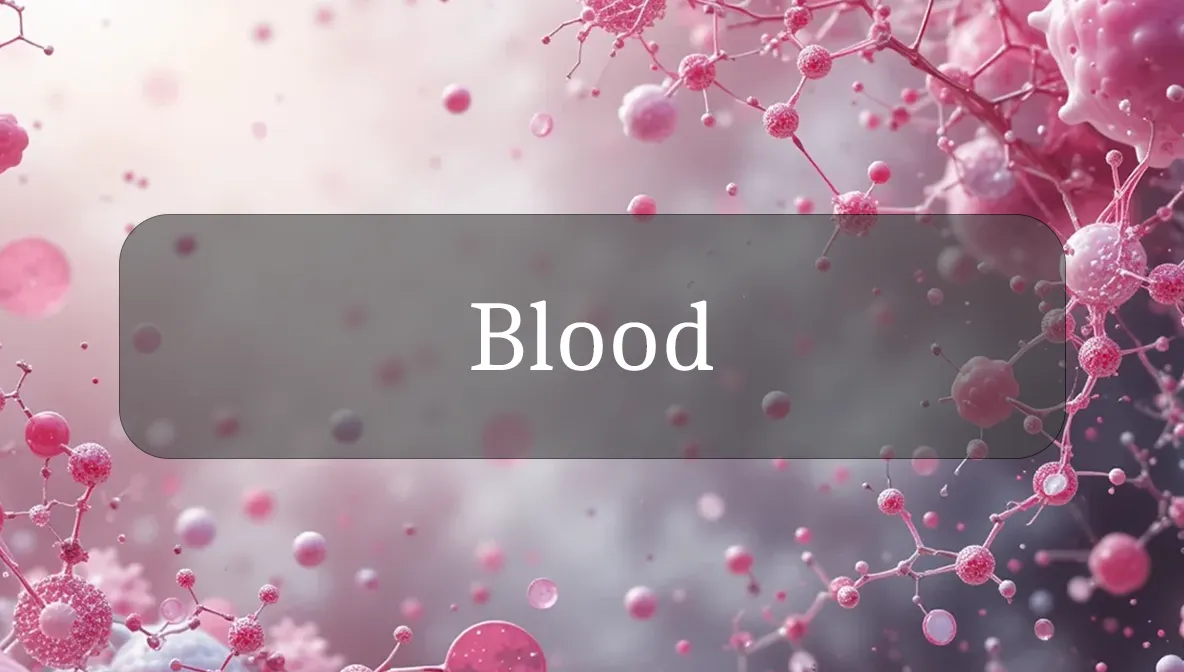Your Body’s Lifeline for Energy and Health
Blood is the unsung hero flowing through your veins, delivering oxygen, nutrients, and vital signals to every part of your body. It’s like a bustling highway system that keeps you energized, healthy, and resilient. Let’s explore what blood does, why it’s essential for your wellness, and how to keep it in top shape for daily vitality.
Identity and Function
Blood is a specialized body fluid made up of four main components: red blood cells (carry oxygen), white blood cells (fight infections), platelets (help clotting), and plasma (the liquid that carries everything else). It circulates through your heart, arteries, and veins, acting as your body’s delivery and cleanup crew. Blood transports nutrients, hormones, and oxygen to cells, removes waste, regulates temperature, and defends against germs.
Health Benefits and Physiological Role
Blood is critical for keeping you alive and thriving:
- Oxygen Delivery: Red blood cells carry oxygen from your lungs to every cell, powering energy and organ function.
- Nutrient Transport: Blood delivers glucose, amino acids, and fats to fuel your muscles, brain, and tissues.
- Immune Defense: White blood cells fight off bacteria, viruses, and other invaders, keeping you healthy.
- Clotting and Healing: Platelets stop bleeding by forming clots, helping wounds heal.
- Waste Removal: Blood carries waste like carbon dioxide and urea to your lungs and kidneys for elimination.
- Body Balance: It regulates pH, temperature, and fluid levels, keeping your systems stable.
By doing all this, blood supports your energy, focus, and ability to stay active and well.
Production and Sources
Your body constantly produces blood components to keep you healthy:
- Where It’s Made: Bone marrow produces red blood cells, white blood cells, and platelets. Plasma, the liquid part, is made mostly of water from your diet, with proteins from the liver.
- Dietary Support: Key nutrients fuel blood production:
- Iron: Found in spinach, red meat, and lentils, it’s essential for red blood cells.
- Vitamin B12 and Folate: Eggs, fish, and leafy greens support cell production.
- Protein: Chicken, beans, or tofu provide amino acids for plasma proteins.
- Hydration: Drinking water (8–10 cups daily) keeps plasma volume balanced.
- Medical Sources: Blood transfusions or plasma donations can replace blood in emergencies, but these are medical interventions, not dietary sources.
A nutrient-rich diet ensures your body has the raw materials to make healthy blood.
Signs of Imbalance
Blood imbalances can show up as symptoms or through blood tests:
- Low Red Blood Cells (Anemia):
- Fatigue, weakness, or pale skin.
- Shortness of breath or dizziness.
- Low White Blood Cells:
- Frequent infections or slow healing.
- Fever or fatigue without clear cause.
- Low Platelets:
- Easy bruising, bleeding gums, or slow clotting.
- Plasma/Electrolyte Issues:
- Swelling, muscle cramps, or irregular heartbeat from imbalanced sodium or potassium.
- Dehydration symptoms like thirst or confusion. If you notice persistent tiredness, bruising, or infections, see a doctor for blood tests to check for issues like anemia or clotting disorders.
Supporting Healthy Function
Keep your blood healthy with these practical tips:
- Eat Nutrient-Dense Foods: Include iron-rich foods (spinach, beef), B12 sources (salmon, eggs), and folate-rich veggies (broccoli, asparagus) to support blood cell production.
- Stay Hydrated: Drink 8–10 cups of water daily to maintain plasma volume and circulation.
- Exercise Regularly: Activities like walking, cycling, or yoga boost blood flow and oxygen delivery.
- Avoid Smoking and Limit Alcohol: These can damage blood cells and impair circulation.
- Get Regular Checkups: Blood tests (e.g., complete blood count) monitor red cells, white cells, and platelets, catching imbalances early.
Safety and Precautions
Blood is a natural fluid, but health conditions or treatments require care:
- Medical Conditions: Anemia, leukemia, or clotting disorders (like hemophilia) need medical management to keep blood healthy.
- Blood Transfusions: Used in emergencies, these carry risks like infections or reactions, so they’re done under strict medical supervision.
- Medications: Blood thinners (e.g., aspirin) or chemotherapy can affect blood function, so follow your doctor’s guidance.
- Infections: Practice good hygiene to avoid bloodborne infections like hepatitis, especially if donating or receiving blood. If you’re managing a blood-related condition or notice symptoms like unusual bleeding or fatigue, consult a healthcare provider.
Fun Fact
Did you know your body contains about 5 liters of blood, and it circulates through your entire system every minute? That’s like a super-efficient courier service making 1,440 round trips a day to keep you going!
Citations
- National Institutes of Health (NIH): Blood and Its Components.
- Mayo Clinic: Blood Basics and Disorders.
- Cleveland Clinic: Understanding Blood Function.
- World Health Organization (WHO): Blood Safety and Health.
- American Red Cross: Blood Components and Functions.

